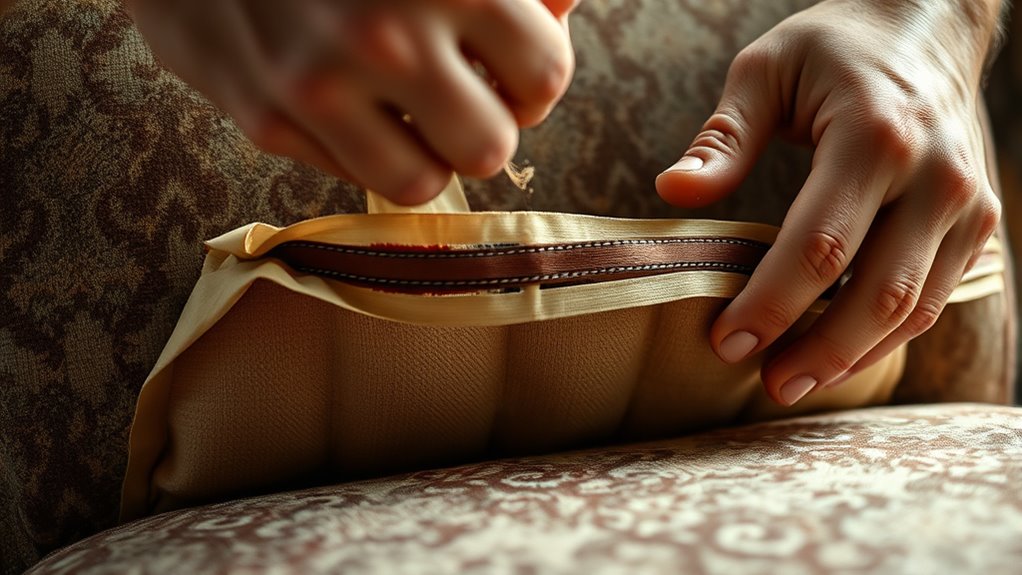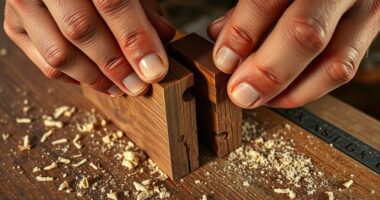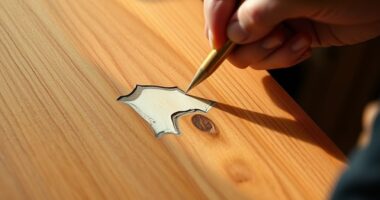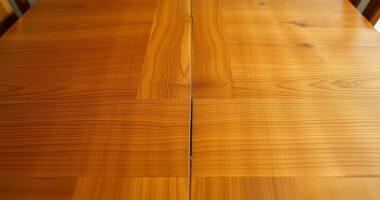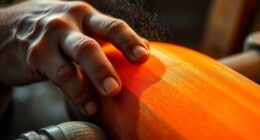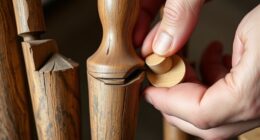To repair upholstered seats by replacing webbing and padding, start by carefully removing the old fabric and webbing. Check the springs and replace or tighten them to restore support. Cut new webbing strips and secure them tightly to the frame using staples or tacks, ensuring even tension. Add fresh padding or foam to replace worn areas, then stretch and staple the new fabric smoothly over the seat. If you want detailed step-by-step instructions, keep exploring for more tips.
Key Takeaways
- Remove old fabric, webbing, and padding carefully to access the seat’s internal structure.
- Replace damaged webbing with sturdy, high-quality material and secure it tightly with staples or tacks.
- Assess and restore spring tension or replace springs to ensure proper support and comfort.
- Add or replace padding with foam or batting to improve cushioning and overall seat support.
- Stretch new fabric tightly over the seat frame, securing it evenly to prevent wrinkles and ensure durability.

If your upholstered seat has seen better days, you don’t have to replace it—repairing it can be a simple and cost-effective solution. Over time, the cushioning and support can sag, and the fabric may become worn or torn. The good news is that you can restore your seat’s comfort and appearance by addressing the underlying issues like spring tension, webbing, and fabric. Restoring spring tension is essential because it directly affects the seat’s support and comfort. If the springs have become loose or saggy, replacing or tightening them can make a significant difference. You might need to remove the old webbing or straps that hold the springs in place and replace them with new, sturdy webbing. This process involves cutting away the damaged webbing and securing new strips with staples or upholstery tacks, ensuring the springs are evenly tensioned and taut. Proper spring tension provides the foundation for a comfortable seat, preventing you from sinking too low or feeling uneven support. Additionally, using a high-quality webbing material can improve durability and longevity of the repair.
Once the springs are re-tensioned, you’ll want to focus on fabric replacement. Over time, fabric can become stained, frayed, or faded, detracting from your seat’s overall look. Removing the old fabric involves carefully detaching it from the frame, being cautious not to damage the underlying padding or webbing. When selecting new fabric, choose a durable upholstery material that matches your style and suits the seat’s use. Stretch the fabric tightly over the padding and secure it with staples along the frame edges, making sure there are no wrinkles or slack. A taut, smooth cover not only looks better but also prolongs the life of your seat. If your seat has padding that’s worn or compressed, replacing or adding foam or batting can further restore comfort and shape.
Throughout the repair process, pay close attention to the tension of the webbing and springs. Proper tension guarantees the seat remains supportive and comfortable for years to come. You might find that adjusting spring tension or replacing old webbing is a straightforward task, but it can make a dramatic difference in how your upholstered seat feels and looks. With patience and the right tools, you can breathe new life into an old seat without the expense of buying a new one. The key is to work systematically—tightening springs, replacing webbing, and replacing fabric—so your repaired seat offers both aesthetic appeal and functional comfort.
Frequently Asked Questions
How Do I Choose the Right Webbing Material for My Seat?
You should choose webbing types based on your seat’s weight and usage; for example, nylon offers strength and flexibility, while jute provides a natural, eco-friendly option. Consider padding materials like foam or batting for comfort, ensuring they match your desired firmness. Think about durability, comfort, and ease of installation when selecting webbing types and padding materials, so your seat remains supportive and comfortable over time.
Can I Repair Upholstery Without Removing the Entire Seat?
Yes, you can repair upholstery without removing the entire seat. Start by carefully inspecting the seat frame and identifying damaged areas. If only the webbing or padding needs attention, you can often access them through small sections of upholstery removal. Use a screwdriver to gently lift the fabric, then replace or reinforce the webbing and padding. This approach saves time and effort while ensuring a sturdy, comfortable seat.
How Long Does a Typical Upholstery Repair Last?
Think of your upholstery repair like restoring a vintage car; with quality work, it can last for years. Typically, a well-done repair with durable materials, including sustainable fabrics, lasts around 5 to 10 years. Factors like usage and maintenance influence longevity, but proper care maintains your restored piece looking great. For vintage restoration, choosing high-quality fabrics ensures your seat stays comfortable and stylish for the long haul.
Are There Eco-Friendly Options for New Padding?
Yes, there are eco-friendly options for new padding. You can choose sustainable materials like organic cotton, wool, or latex foam derived from natural sources. Biodegradable options, such as plant-based foam or recycled fiberfill, break down more easily and reduce environmental impact. These choices not only help the planet but also provide comfortable, healthy seating. Opting for eco-conscious padding guarantees your upholstery repair supports sustainability and longevity.
What Tools Are Essential for DIY Webbing Replacement?
Did you know that using proper tools boosts webbing tension by up to 30%? To replace webbing effectively, you’ll need a staple gun, scissors, webbing stretcher, and a flathead screwdriver. These tools help you tighten webbing securely and ensure a smooth, durable finish. Consider padding alternatives like eco-friendly foam or recycled materials to make your project more sustainable. With the right tools, you’ll easily accomplish professional results in your DIY webbing replacement.
Conclusion
With a little patience and the right tools, you can breathe new life into your upholstered seats, making them look as refined as a well-tended Victorian parlor. Remember, replacing webbing and padding isn’t just about function; it’s about preserving a touch of elegance from a bygone era. So, don your apron, channel your inner artisan, and turn your furniture into a masterpiece. After all, even a humble seat can hold the grandeur of a lost age.
